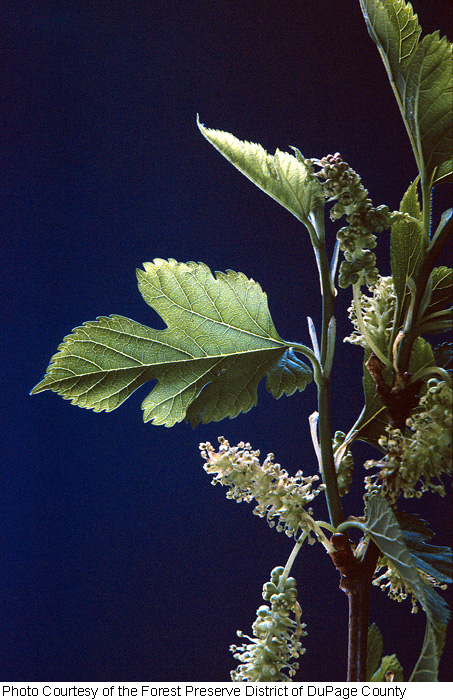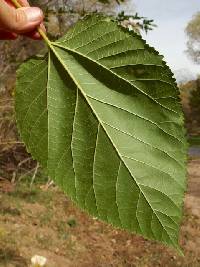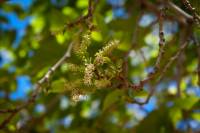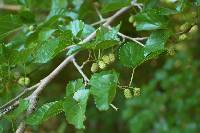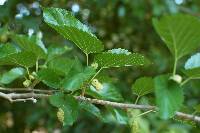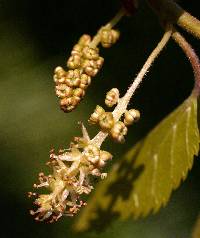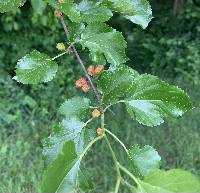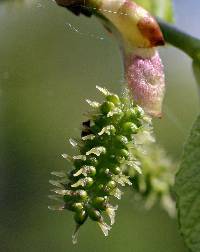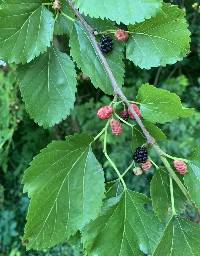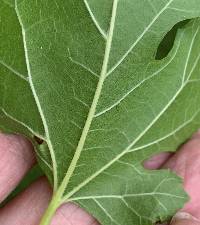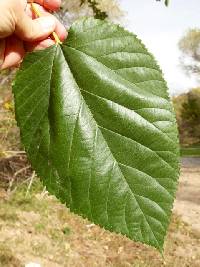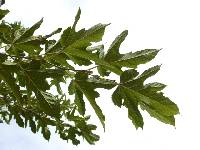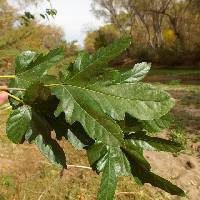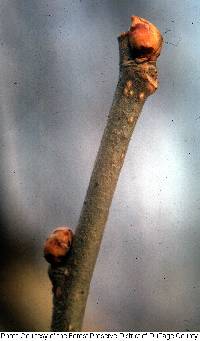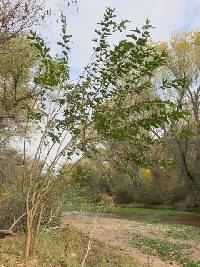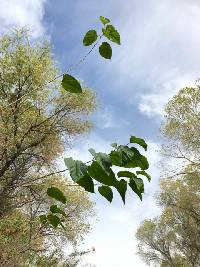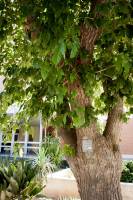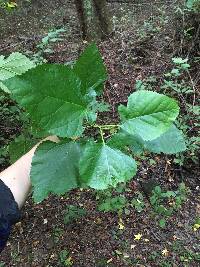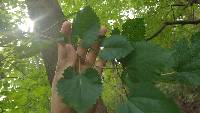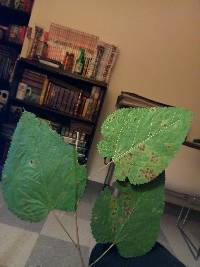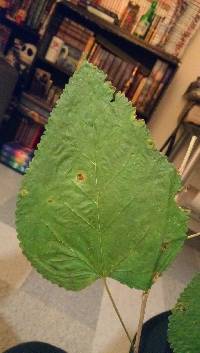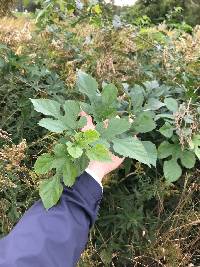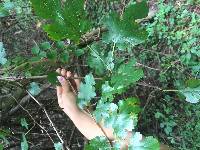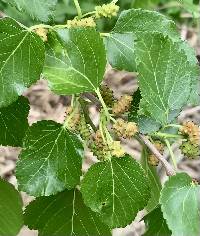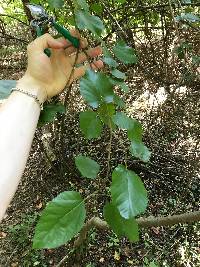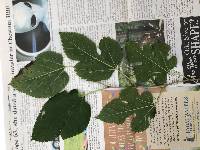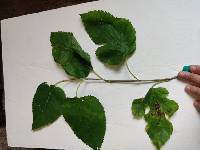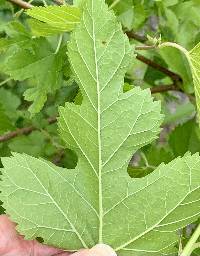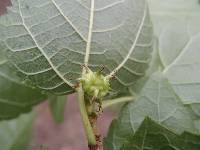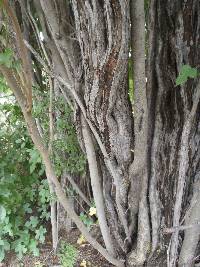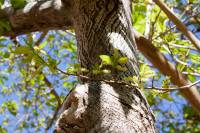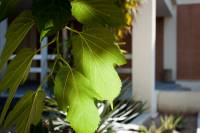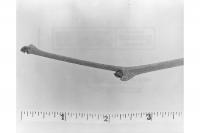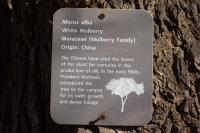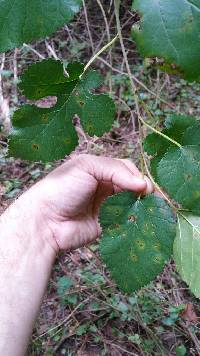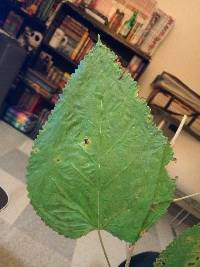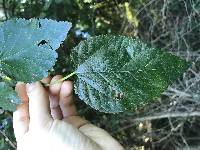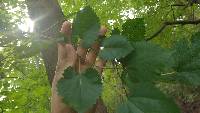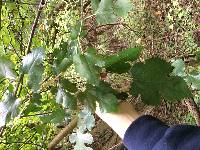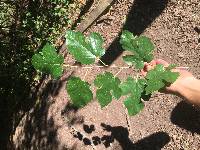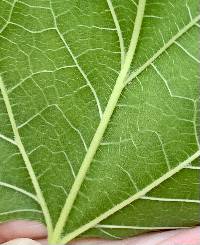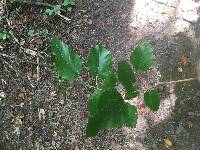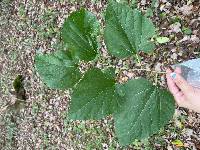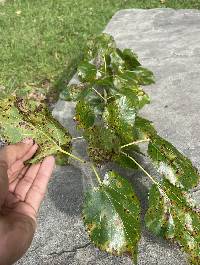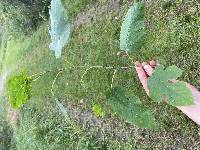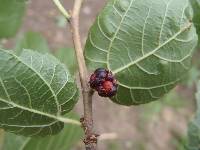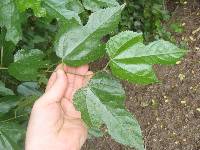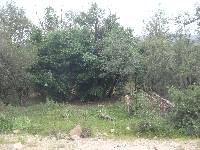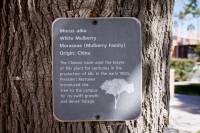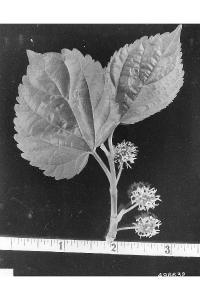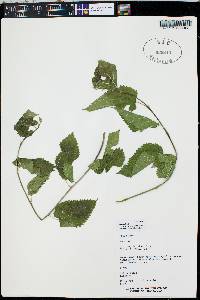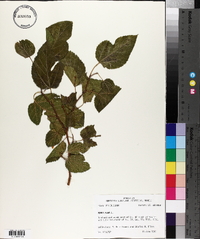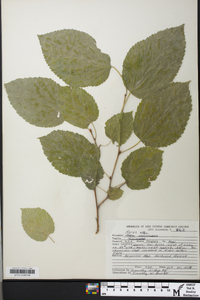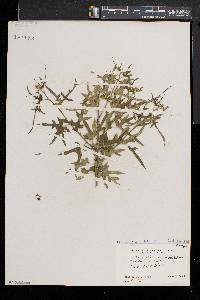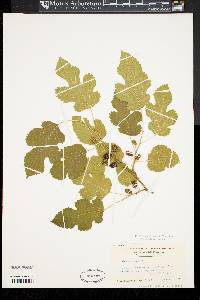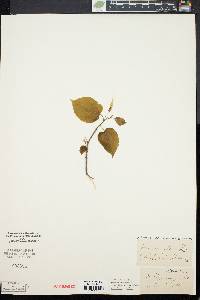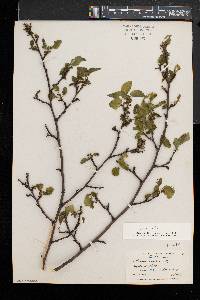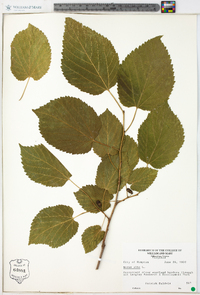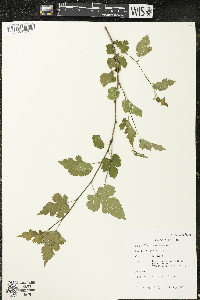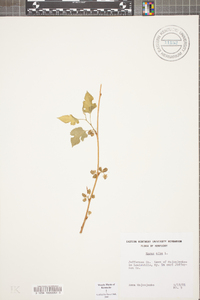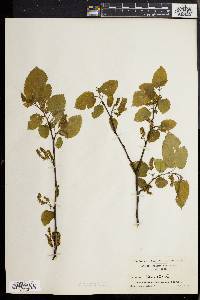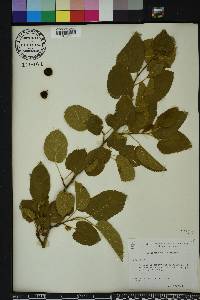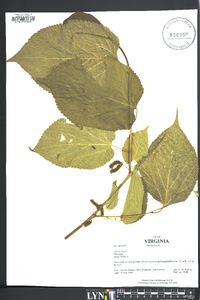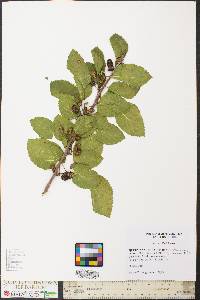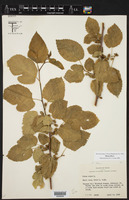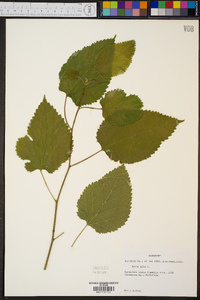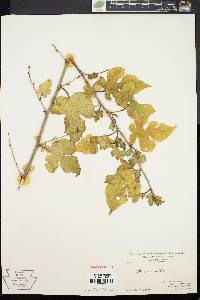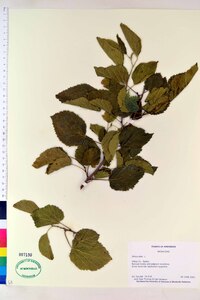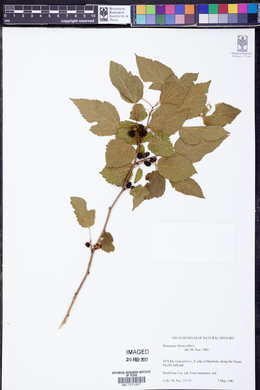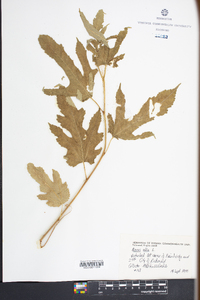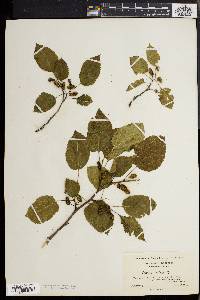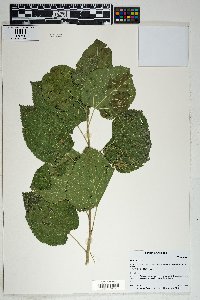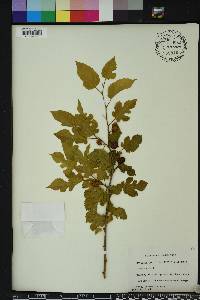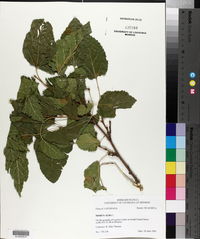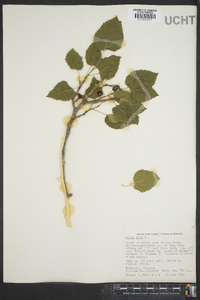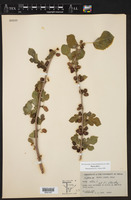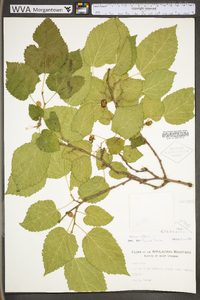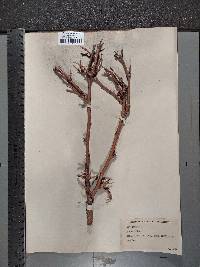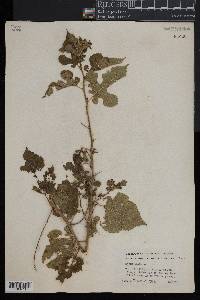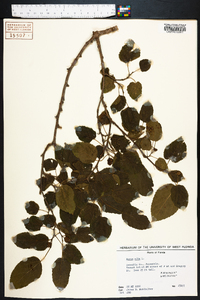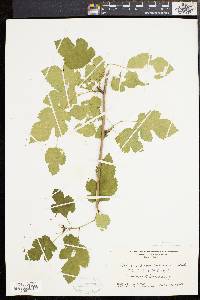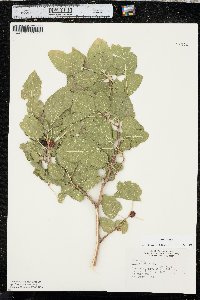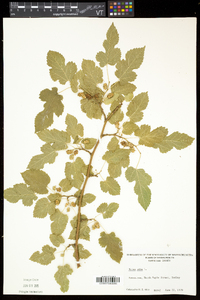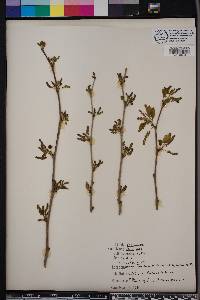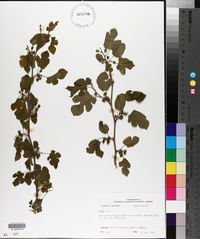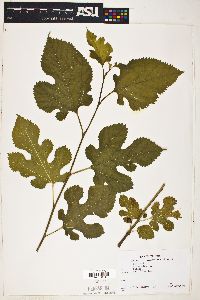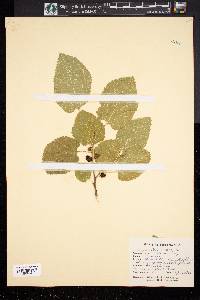Morus alba
|
|
|
|
Family: Moraceae
White Mulberry, more...mulberry
[Morus alba var. alba, moreMorus alba var. multicaulis , Morus alba var. tatarica (L.) Ser., Morus parvifolia Royle, Morus tatarica L.] |
Shrubs or trees , to 15 m. Bark brown tinged with red or yellow, thin, shallowly furrowed, with long, narrow ridges. Branchlets orange-brown or dark green with reddish cast, pubescent or occasionally glabrous; lenticels reddish brown, elliptic, prominent. Buds ovoid, 4-6 mm, apex acute to rounded; outer scales yellow-brown with dark margins, glabrous or with a few marginal trichomes; leaf scars half round, bundle scars numerous, in circle. Leaves: stipules ovate to lanceolate, 5-9 mm, pubescent; petiole 2.5-5 cm, short-pubescent. Leaf blade ovate, often deeply and irregularly lobed, (6-)8-10 × 3-6 cm, base cuneate, truncate, or cordate, margins coarsely serrate to crenate, apex acute to short-acuminate; surfaces abaxially glabrous or sparingly pubescent along major veins or in tufts in axils of principal lateral veins and midribs, adaxially glabrous to sparsely pubescent. Catkins: peduncle and axis pubescent; staminate catkins 2.5-4 cm; pistillate catkins 5-8 mm. Flowers: staminate and pistillate on same or different plants. Staminate flowers: sepals distinct, green with red tip, ca. 1.5 mm, pubescent; filaments ca. 2.7 mm. Pistillate flowers: ovary green, ovoid, slightly compressed, ca. 2 mm, glabrous; style branches divergent, red-brown, 0.5-1 mm; stigma papillose. Syncarps red when immature, becoming black, purple, or nearly white, cylindric, 1.5-2.5 × 1 cm; achenes light brown, ovoid, 2-3 mm. Flowering spring-summer. Disturbed areas, woodland margins, fencerows, dry to moist thickets; 0-1500 m; introduced; Ont.; Ala., Ark., Colo., Conn., Del., D.C., Fla., Ga., Ill., Ind., Iowa, Kans., Ky., La., Maine, Md., Mass., Mich., Minn., Miss., Mo., Nebr., N.H., N.J., N.Y., N.C., Ohio, Okla., Pa., R.I., S.C., S.Dak., Tenn., Tex., Vt., Va., W.Va., Wis.; Europe; native to e Asia. Morus alba is sometimes planted and possibly naturalized in Arizona, California, and New Mexico. It is reported from Washington as a local escape. Mulberry leaves provide the natural food for silkworms. Commercially cultivated mulberries are varieties of Morus alba ; they are prized as shade trees with edible fruits. Morus alba and M . rubra are both highly variable and are often confused. Both species have deeply lobed to entire leaves and are variable in pubescence. Some individuals are intermediate in leaf pubescence, suggesting the possibility of hybridization. Native Americans used infusions made from the bark of Morus alba medicinally in various ways: as a laxative, as a treatment for dysentary, and as a purgative (D. E. Moerman 1986.
Tree 6 - 18 m tall, trunk 30 cm - 0.8 m in diameter Leaves: alternate, with a stalk producing milky juice and egg- to lance-shaped stipules. The blades are shiny light green above, paler and sometimes hairy-veined beneath, 5 - 10 cm long, almost as wide, egg-shaped with a rounded to heart-shaped base and a short pointed or blunt tip, coarsely toothed. The number of lobes per leaf is variable (polymorphic), and newer growth is usually more highly lobed. Flowers: either male or female, usually found on different trees (dioecious), yellowish green, borne on short-stalked catkins, male catkins 2 - 5 cm long, female catkins 0.5 - 2.5 cm long. Fruit: a cluster of multiple fruits formed from single ovaries of multiple flowers in an inflorescence, with the fleshy part composed of enlarged calyx lobes. The multiple fruits are white to pink, sometimes red to purple, and 1 - 2 cm long. Bark: gray, becoming orangish brown to brown with visible orange inner bark at bases of shallow furrows. Twigs: reddish brown and slightly hairy, becoming shiny yellowish brown to light orange and smooth, scattered with prominent reddish brown, corky, raised spots (lenticels), secreting milky juice when cut. Buds: off-centered above the leaf scars, shiny light brown to orangish brown with darker margins, 3 - 4 mm long, egg-shaped, with scales that are slightly hairy along the margins. Terminal buds are absent. Leaf scars: semicircular, containing a circle of many raised bundle scars. Form: dense and rounded, with many fine branches. Similar species: Morus alba and Morus rubra are very similar species. However, M. alba is an introduced, invasive species, and M. rubra is a native species declining in numbers. Morus rubra is not seen in urban areas very often. It also has larger, duller leaves with a downy lower surface, longer fruit that is red to black, longer buds that are not pressed as closely to the stem, and bark that is less orange than the bark of M. alba. Flowering: early May to mid June Habitat and ecology: Disturbed sites, edges of woods, wooded floodplains, alleys, along railroads and roadsides. Occurence in the Chicago region: non-native Notes: The leaves of this species are the food source for the silkworm. Morus alba was introduced from Asia to establish a silkworm industry in the United States, where it also became a popular shade and fruit tree. Wildlife commonly eat the fruit and disperse the seeds in natural areas, where it has become invasive. Today, landscape use is mostly limited to fruitless weeping or dwarf cultivars. Mulberry fruit resembles an elongated raspberry, but is structurally very different. Raspberries are aggregate fruits formed from multiple ovaries in a single flower, while mulberries are multiple fruits formed from single ovaries of multiple flowers in an inflorescence. The enlarged ovary is the fleshy part of a raspberry, while the enlarged calyx lobe is the fleshy part of a mulberry. Etymology: Morus is the Latin name for mulberry. Alba comes from the Latin word meaning white. Author: The Morton Arboretum FNA 1997 Common Name: white mulberry Duration: Perennial Nativity: Non-Native Lifeform: Tree Wetland Status: FAC General: Shrubs or trees to 15 m, thin bark with shallow furrows, brown with yellow or red tinge, young branches orange brown to dark green, pubescent or smooth. Leaves: Ovate with deep and irregular lobes, margins toothed, sparsely pubescent on both the underside and top of leaf, especially along major veins. Flowers: Staminate catkins 2.5-4 cm, pistillate catkins 5-8 mm, can be both staminate and pistillate on the same plant. Staminate flowers with distinct sepals, green with red tips, pistillate flowers with smooth, green ovaries. Fruits: Syncarps red when young, purple, white, or black when mature. Ecology: Found in disturbed areas in woodland margins, along fences, and in thickets below 5,000 ft (1524 m); flowers spring-summer. Notes: This species can be tricky. According to FNA, Morus alba is often confused with M. rubra,as both are highly variable in pubescence and thought to possibly hybridize, however, according to the key, M. rubra has short, stiff, appressed trichomes on the underside of the leaf, while M. alba has only sparse pubescence . Furthermore M. microphylla has a leaf blade less than 7 cm, while M. alba is generally longer than 8 cm. Ethnobotany: An infusion of the bark taken as an anthelmintic (for worms), as an antidiarrheal medicine, a laxitive, and as a cathartic (purgative). The fruit also used as food. Etymology: Morus is the classical name for mulberry, alba means white. Synonyms: None Editor: LCrumbacher, 2011 Tree to 15 m; lvs glabrous or nearly so, or with white, spreading hairs along the veins beneath, acute or short-acuminate, otherwise as in no. 1 [Morus rubra L.]; fr white, pink, or pale purple to nearly black; 2n=28. Native of e. Asia, often escaped from cult. in our range. Gleason, Henry A. & Cronquist, Arthur J. 1991. Manual of vascular plants of northeastern United States and adjacent Canada. lxxv + 910 pp. ©The New York Botanical Garden. All rights reserved. Used by permission. From Flora of Indiana (1940) by Charles C. Deam This species was formerly recommended for forest planting for growing fence post timber. It is a small, crooked tree and is a failure for the purpose recommended. It is very hardy and annually produces an abundant crop of fruit which is greedily eaten by birds. Through the agency of birds this species has become widely distributed in woodland and along fences. A neighbor 3 blocks away has a large tree in his yard and each year I have the task of digging about 50-100 seedlings from our garden. .…… Indiana Coefficient of Conservatism: C = null, non-native Wetland Indicator Status: FAC Diagnostic Traits: thornless tree with alternate leaves, the leaves ranging from cordate-ovate to variously lobed; upper leaf surface glossy; palmate veins of lower leaf surface usually glabrous or hairs tufted in axils of veins; stems glabrous; fruit cluster short-cylindric, black, purple, red, pink, or white. |
|
|
|

